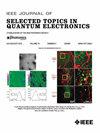Numerical Modeling of Integrated Coherent Ising Machine Using Spatially Multiplexed Silicon Nitride Microresonators
IF 5.1
2区 工程技术
Q1 ENGINEERING, ELECTRICAL & ELECTRONIC
IEEE Journal of Selected Topics in Quantum Electronics
Pub Date : 2025-03-20
DOI:10.1109/JSTQE.2025.3571522
引用次数: 0
Abstract
In this paper, we present mathematical modeling and numerical analysis of an integrated coherent Ising machine (CIM) consisting of a network of coupled add-drop microring resonators. The proposed CIM exploits dual-pumped degenerate optical parametric oscillators (DOPOs) in silicon nitride (SiN), as a CMOS-compatible material, combined with all-optical reconfigurable spatial multiplexing. This approach benefits from the potential of on-chip all-optic computing to solve large-scale NP-hard computational problems, paving the way for a scalable and programmable photonic-based CIMs. We provide design considerations for the optimal phase-sensitive parametric amplifiers by using SiN-based DOPOs to implement a photonic Ising spin as the fundamental building block for CIMs. The binary coherent states of each spin can be optimized by controlling the power of both pumps and their detunings. We also explore the parameter space of optical coupler structures to realize ferromagnetic and antimagnetic coupling between DOPOs, which is required for mapping quadratic unconstrained binary optimization problems (QUBO) to the integrated Ising machine composed of a network of coupled DOPOs. Furthermore, the balanced and unbalanced coupling scenarios between spins are compared for improving spin-state homogeneity. Finally, the time evolution of sixteen coupled microresonators during ground-state search has been investigated as a proof-of-concept under different coupling schemes.空间复用氮化硅微谐振腔集成相干Ising机的数值模拟
在本文中,我们提出了一个由耦合加降微环谐振器网络组成的集成相干伊辛机(CIM)的数学建模和数值分析。所提出的CIM利用氮化硅(SiN)中的双泵浦简并光参量振荡器(DOPOs)作为cmos兼容材料,结合全光可重构空间复用。这种方法得益于片上全光计算解决大规模np困难计算问题的潜力,为可扩展和可编程的基于光子的cim铺平了道路。我们通过使用基于sino的dopo来实现光子伊辛自旋作为cim的基本构建块,为最佳相敏参数放大器提供了设计考虑。每个自旋的二元相干态可以通过控制两个泵浦的功率和它们的失谐来优化。我们还探索了光学耦合器结构的参数空间,以实现dopo之间的铁磁和反磁耦合,这是将二次无约束二元优化问题(QUBO)映射到由耦合dopo网络组成的集成Ising机器所必需的。此外,为了提高自旋态的均匀性,比较了平衡和不平衡的自旋耦合情况。最后,对16个耦合微谐振器在基态搜索过程中的时间演化进行了研究,并对不同耦合方案下的时间演化进行了概念验证。
本文章由计算机程序翻译,如有差异,请以英文原文为准。
求助全文
约1分钟内获得全文
求助全文
来源期刊

IEEE Journal of Selected Topics in Quantum Electronics
工程技术-工程:电子与电气
CiteScore
10.60
自引率
2.00%
发文量
212
审稿时长
3 months
期刊介绍:
Papers published in the IEEE Journal of Selected Topics in Quantum Electronics fall within the broad field of science and technology of quantum electronics of a device, subsystem, or system-oriented nature. Each issue is devoted to a specific topic within this broad spectrum. Announcements of the topical areas planned for future issues, along with deadlines for receipt of manuscripts, are published in this Journal and in the IEEE Journal of Quantum Electronics. Generally, the scope of manuscripts appropriate to this Journal is the same as that for the IEEE Journal of Quantum Electronics. Manuscripts are published that report original theoretical and/or experimental research results that advance the scientific and technological base of quantum electronics devices, systems, or applications. The Journal is dedicated toward publishing research results that advance the state of the art or add to the understanding of the generation, amplification, modulation, detection, waveguiding, or propagation characteristics of coherent electromagnetic radiation having sub-millimeter and shorter wavelengths. In order to be suitable for publication in this Journal, the content of manuscripts concerned with subject-related research must have a potential impact on advancing the technological base of quantum electronic devices, systems, and/or applications. Potential authors of subject-related research have the responsibility of pointing out this potential impact. System-oriented manuscripts must be concerned with systems that perform a function previously unavailable or that outperform previously established systems that did not use quantum electronic components or concepts. Tutorial and review papers are by invitation only.
 求助内容:
求助内容: 应助结果提醒方式:
应助结果提醒方式:


